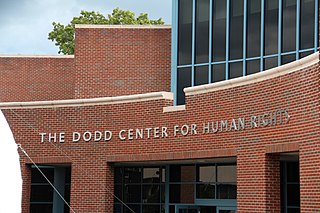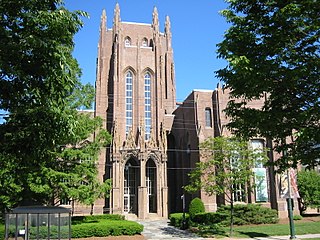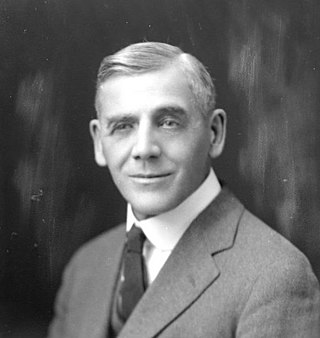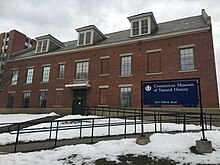
The University of Connecticut (UConn) is a public land-grant research university system with its main campus in Storrs, Connecticut. It was founded in 1881 as the Storrs Agricultural School, named after two benefactors. In 1893, the school became a public land grant college, then took its current name in 1939. Over the following decade, social work, nursing, and graduate programs were established. During the 1960s, UConn Health was established for new medical and dental schools. UConn is accredited by the New England Commission of Higher Education.
UConn Health is a healthcare system and hospital, and branch of the University of Connecticut that oversees clinical care, advanced biomedical research, and academic education in medicine. The system is funded directly by the State of Connecticut and the University’s financial endowment. Its primary location, UConn John Dempsey Hospital, is a teaching hospital located in Farmington, Connecticut, in the US. In total, UConn Health comprises the hospital, the UConn School of Medicine, School of Dental Medicine, and Graduate School. Additional community satellite locations are located in Avon, Canton, East Hartford, Putnam, Simsbury, Southington, Storrs-Mansfield, Torrington, West Hartford, and Willimantic, including two urgent cares in both Storrs-Mansfield and Canton. UConn Health also owns and operates many smaller clinics around the state that contain UConn Medical Group, UConn Health Partners, University Dentists and research facilities. Andrew Agwunobi stepped down as the CEO of UConn Health in February 2022 after serving since 2014 for a private-sector job. Bruce Liang was UConn Heath's interim CEO for 2022-2024 and remains dean of the UConn School of Medicine. Andrew Agwunobi returned to UConn Health as Executive Vice President of Health Affairs and CEO beginning May 31, 2024.

Mark Edward Freitas Ice Forum was a 2,000-seat hockey rink in Storrs-Mansfield, Connecticut. It was the longtime home arena and recent practice facility for the University of Connecticut women's and men's college ice hockey teams.
The University of Connecticut (UConn) School of Business is the University of Connecticut's graduate and undergraduate public business school. It spans across four campuses, with the main campus located in Storrs, Connecticut.

The Bruce Museum is a art, science and natural history museum located in Greenwich, Connecticut.

The Dodd Center for Human Rights is a University of Connecticut center which supports programming, educational initiatives, and events dedicated to the theme of human rights. The complex is located on the main UConn campus in Storrs-Mansfield, Connecticut.

The University of Michigan Museum of Natural History (UMMNH) is a natural history museum of the University of Michigan in Ann Arbor, Michigan, United States.

The Peabody Museum of Natural History at Yale University is one of the oldest, largest, and most prolific university natural history museums in the world. It was founded by the philanthropist George Peabody in 1866 at the behest of his nephew Othniel Charles Marsh, an early paleontologist. The museum is best known for the Great Hall of Dinosaurs, which includes a mounted juvenile Brontosaurus and the 110-foot-long (34 m) mural The Age of Reptiles. The museum also has permanent exhibits dedicated to human and mammal evolution; wildlife dioramas; Egyptian artifacts; local birds and minerals; and Native Americans of Connecticut.

The William Benton Museum of Art is a public fine arts museum located on the University of Connecticut's main campus in Storrs-Mansfield, Connecticut. The Benton houses a permanent collection of over 6,500 artistic works and hosts special exhibitions, concerts, campus art walks, and other events. The museum is named in honor of the prominent U.S. senator and university trustee William Benton. The Benton has a cafe and a gift store. Admission to the museum is free for all.

The Ballard Institute and Museum of Puppetry (BIMP) is a public museum of puppetry operated by the University of Connecticut. The museum is located near the main UConn campus in Storrs-Mansfield, Connecticut.
The University of Connecticut (UConn) Neag School of Education offers undergraduate and graduate degrees in education, sport management, and leadership across four campuses, with the main campus located in Storrs, Connecticut. The Storrs location is the main UConn campus and is home to the Renzulli Center for Gifted Education and Talent Development, and additional locations are in Hartford, Waterbury, and Groton. It is ranked number 16 among public graduate schools of education in the nation. The schools' research and teaching programs have been funded by a wide number of institutions, such as the National Science Foundation and the Department of Education.

Edwina Maud Whitney was an American librarian and educator who served as one of the earliest librarians at the Connecticut Agricultural College from 1900 to 1934. She also served as a German instructor from 1901 to 1926 and an assistant professor of German from 1926 to 1934.

Mary Estella Sprague was an American home economics professor and academic administrator at the University of Connecticut, then Connecticut Agricultural College. She served as dean of women from 1917 to 1926 and as the first dean of the Division of Home Economics from 1920 to 1926.

Carolyn Ladd Widmer was an American nurse educator and academic administrator who served as the first dean of the University of Connecticut School of Nursing. She held this position for twenty-five years (1942–1967).

Benjamin Franklin Koons was an American natural historian who served as second Principal of Storrs Agricultural School (1883–1893) and first President of Storrs Agricultural College (1893–1898), now the University of Connecticut.

Charles Lewis Beach was an American agricultural educator who served as the 4th president of Connecticut Agricultural College, now the University of Connecticut, from 1908 to 1928. Beach played a pivotal role in UConn's development. He also laid the foundations for the future William Benton Museum of Art. Beach is one of only five presidents to hold the honorary title of President Emeritus.

Willis Nichols Hawley was an American soldier who died of typhoid fever during the Spanish–American War. Hawley was the first student or alumnus of the University of Connecticut to die while on active duty during wartime. The Willis Nichols Hawley Armory on the university's campus in Storrs-Mansfield was named in his honor.

Alexey von Schlippe (1915–1988) was a Russian-American painter who became the first full-time professor at the University of Connecticut's Avery Point campus in Groton. Opened in 1992, the Alexey von Schlippe Gallery of Art is a contemporary art gallery in the Branford House.
The Storrs Agricultural Experiment Station (SAES) is an American agricultural experiment station operated by the University of Connecticut and founded in 1887. Part of UConn's College of Agriculture, Health, and Natural Resources, the SAES directs agriculture-related research while the university's Cooperative Extension Service engages in community education and outreach. Kumar Venkitanarayanan is the Station's associate director. Its offices are located in the W. B. Young Building on the main UConn campus in Storrs.
















